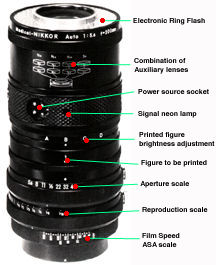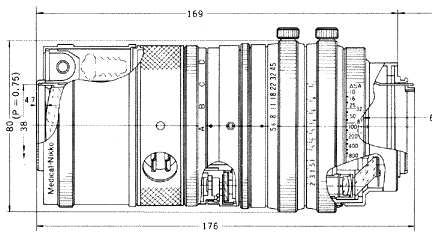
200mm f/5.6 Medical-Nikkor Auto
(Download a PDF file
(187k)
for some reference charts when used with this lens, including info in this page)
| Nikon F | Nikon F2 | Nikon F3 | Nikon F4 | Nikon F5 | Nikon F6 -not ready | Nikkormat / Nikomat | Nikon FM | Nikon FE/ FA | Nikon EM/FG/FG20 | Nikon Digital SLRs | Nikon - Other models |
Nikon Auto Focus Nikkor lenses:-
Main Index Page
Nikon Manual
Focus
Nikkor lenses:- Fisheye-Nikkor Lenses - Circular | Full Frame |
Ultrawides Lenses - 13mm15mm18mm20mm | Wideangle Lenses - 24mm28mm35mm | Standard Lenses - 45mm 50mm 58mm | Telephoto
Lenses - 85mm105mm135mm180mm & 200mm | Super-Telephoto Lenses - 300mm 400mm 500mm 600mm 800mm 1200mm |
 Index Page |
Special
Application lenses: Micro-Nikkor Lenses - 50mm~55mm -60mm 85mm -105mm 200mm Micro-Zoom 70-180mm Perspective Control (PC) - 28mm 35mm PC-Micro 85mm Dedicated Lenses for Nikon F3AF: AF 80mm f/2.8 | AF 200mm f/3.5 EDIF Depth of Field Control (DC): 105mm 135mm Medical Nikkor: 120mm 200mm Reflex-Nikkor Lenses - 500mm 1000mm 2000mm Others: Noct Nikkor | OP-Nikkor | UV Nikkor 55mm 105mm | Focusing Units | Bellows-Nikkor 105mm 135mm Nikon Series E Lenses: 28mm35mm50mm100mm135mm | E-Series Zoom lenses: 36~72mm75~150mm70~210mm |
MF Zoom-Nikkor Lenses: 25~50mm | 28~45mm | 28~50mm | 28~85mm | 35~70mm | 36~72mm E | 35~85mm | 35~105mm | 35~135mm | 35~200mm | 43~86mm | 50~135mm | 50~300mm | 70~210mm E | 75~150mm E | 80~200mm | 85~250mm | 100~300mm | 180~600mm | 200~400mm | 200~600mm | 360~1200mm | 1200~1700mm
Tele-Converters: TC-1 | TC-2 | TC-200 | TC-201 | TC-300 | TC-301 | TC-14 | TC-14A | TC-14B | TC-14C | TC-14E | TC-16 | TC-16A | TC-20E
Recommended links to understand more technical details
related to the Nikkor F-mount and production Serial Number:
http://www.zi.ku.dk/personal/lhhansen/photo/fmount.htm by: Hansen,
Lars Holst
http://www.mir.com.my/rb/photography/hardwares/nikonfmount/lens2.htm
http://www.photosynthesis.co.nz/nikon/serialno.html
Incorporating a ringlight unit around its front element, the Medical-Nikkor is
ideal for close-up work in the field of medicine, and has numerous other applications
in science and industries.
It consists of a prime lens, a set of six auxiliary lenses and an AC or a battery
power source for operating the lighting units.
The lens offers a choice of eleven different magnification ratios in combination
with the six auxiliary lenses. (The prime lens alone gives the reproduction ratio
of 1/1 5X and the auxiliary lenses, attached singlely or in varied combinations,
provide a range of magnification ratios from 1/8X to 3X).
The Medical-Nikkor is self-compensating, eliminating all bothersome calculations
for setting the diaphragm in relation to film speed and reproduction ratio. All that
is required of the photographer is to set the lens for the ASA speed of the film
used, attach the auxiliary lens or lenses in accordance with the desired magnification
ratio, focus by moving the camera toward or away from the subject and release the
shutter.
The automatic lens diaphragm stops down to correct aperture at the moment of exposure.
Two illumination units are built into the lens: an electronic ringlight and pilot
lamps.
The ringlight surrounds the front element of the lens to produce even and shadowless
illumination. It may be removed from the lens for servicing and for providing special
lighting angles. The color temperature of 6000° K permits the use of daylight
color film. The flash duration is 1/500 second. The Medical-Nikkor ringlight synchronizes
with the Nikon F2 at the shutter speed of 1/60 second, with the Nikon F at 1/30 second,
and the Nikkormat at 1/60 second.
Positioned behind the ringlight are four incandescent bulbs that comprise the pilot
lamps. These facilitate precise focusing in the dark. The lens also incorporates
a device for printing an identification number (1 to 39) or magnification ratio (1/15X
to 3X) in the lower right-hand corner of each frame by making use of a small fraction
of the ringlight output or "leak" flash.
These figures serve as references, key numbers or as a guide to "right-side-up"
projection. The intensity of the "leak" flash can be adjusted in three
steps as indicated by "A,', "B" and "G" on the Identification
Number/Reproduction Ratio Adjuster. When an unnumbered negative is required, the
imprinting device can be blocked off by setting the adjuster to "D".
The Photomic series finders function solely as a viewfinder when used with the Medical
Nikkor. The self-compensating feature of the lens diaphragm eliminates the need for
exposure metering.

Focal length: 200mm
Maximum aperture: 1:5.6
Lens construction: 4 elements in 4 groups
Picture angle: 12°20'
Aperture scale: f/5.6 - f/45
Aperture diaphragm: Fully automatic
Attachment size: 38mm (P=0.75)
Dimensions: 80mm dia. X 176mm length, (3 5/32 in. X 6-15/16 in.)
Weight: 670g (23.60z)
Accessories:
38mm screw-in front cap,
rear captype F,
safety camera shoe cover,
6 auxiliary ienses: 1 /8X, 1/6X, 1/4X, 1/2X, 1X, 2X,
AC power unit, DC power unit,
synch cord, 1.5m power source cord, 1.6m power source cord,
leather compartment case,
2.5V light bulb.



